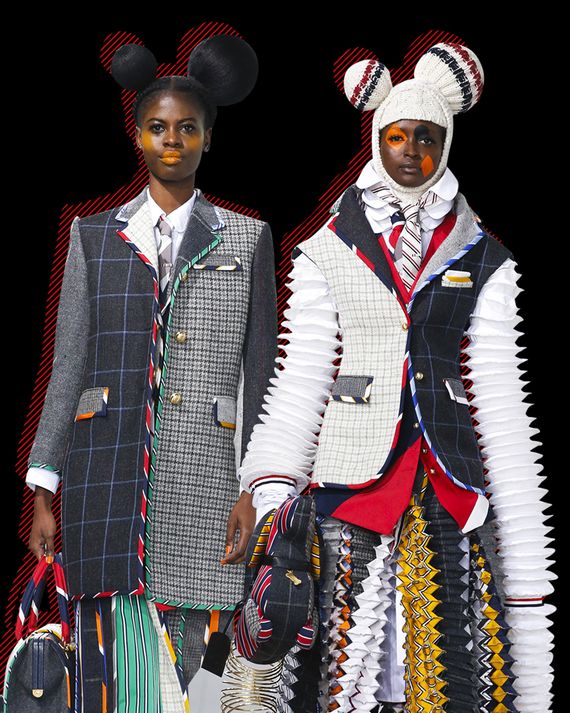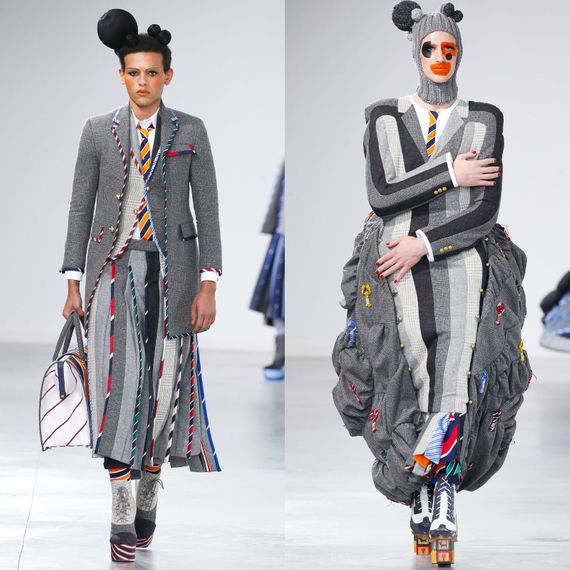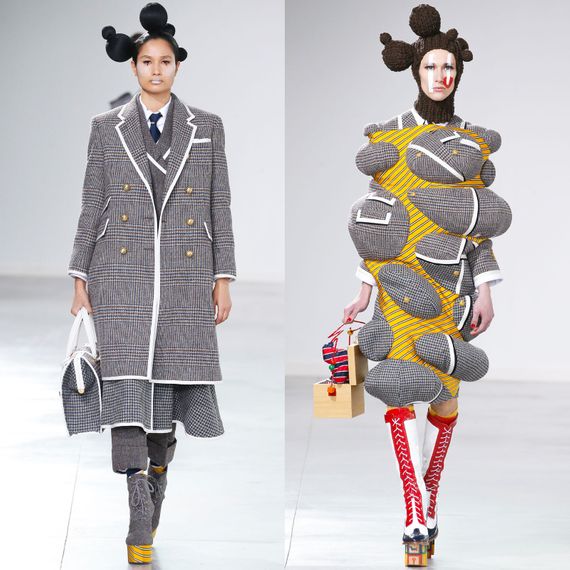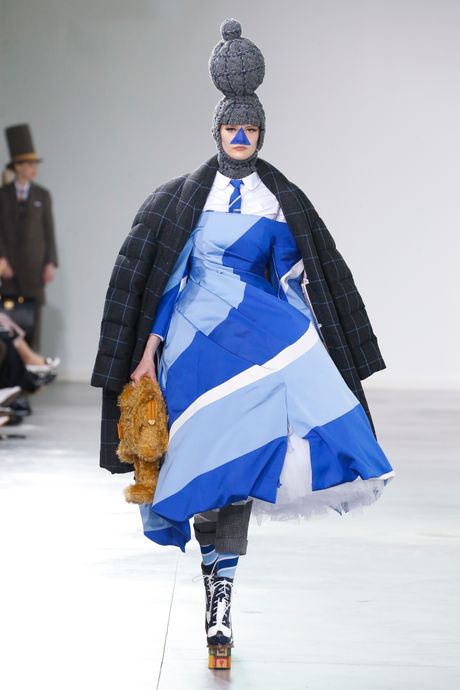
This past Friday, Thom Browne brought his fall 2022 men’s and women’s show to the Javits Center, a convention center that doesn’t exactly beckon thoughts about high fashion. Nonetheless, the timing had to do with the opening tonight of “In America: An Anthology of Fashion,” the second part of an exhibit exploring American style at the Metropolitan Museum of Art, where Browne’s partner, Andrew Bolton, is the chief costume curator. Given the complexity of “In America,” which encompasses the shenanigans of the Met Gala and, perhaps more dauntingly, is staged in collaboration with curators of the Met’s period rooms, Browne wanted to be supportive. At the same time, he could continue to dig into his own American themes before returning to his primary base in Paris. COVID-19 has kept him away from France since the fall of 2019.
Dominating a huge exhibition hall was a low white platform arranged with 500 small teddy bears dressed in Browne’s trademark gray suiting. The bears were seated in precision rows as if at bear military school. At the head of the class was an oversize chair — soon occupied by the “head bear,” an overanimated model in brown plush fur boots with a gray cape and a goofily high stovepipe hat. A voice-over intoned that people come to New York to discover their authentic selves.
So the elements were in place: childhood, a sense of play (through toys), the cliché of self-discovery in the big city. In Europe, there’s a long history of designers referencing childhood and dolls, though with far more discomfort; I think of two Galliano shows, from 2000 and 2004, in which models wore oversize paper-doll dresses, and a McQueen show inspired by Hans Bellmer’s Surrealist use of dolls. A Galliano Dior show also featured, memorably, oversize salon-style furniture on the catwalk.
Browne’s show ran in two distinct segments. The first had his models in his classic masculine tailoring, emphasizing heritage tweeds and repp-tie silks, while the second took those same elements and exploded them in scale and absurdity. The twin, for example, of a modest two-tone gray tweed blazer and pleated skirt with tie-silk panels was a gigantic blazer in the same tweeds now spread over a skirt ballooned by a crinoline. For a slim jacket and patchwork skirt, the twin was an ultrapadded, accordion-stitched jacket with a skirt made of streamers of crinkled wool, each as bouncy as a jack-in-the-box. The more classic looks featured hairpieces shaped in random but perfectly round balls, like Styrofoam planets in a science-fair project, while the extreme looks came with knitted ball-shaped caps and makeup that suggested cockeyed toy soldiers. Features such as eyes looked slightly wonky. Again, there’s a precedent: McQueen and Galliano’s disturbing use of makeup, inspired by the performance artist Leigh Bowery and also Rei Kawakubo of Comme des Garçons.
Looking at Browne’s toy-inspired accessories — a Slinky bag, shoes on platforms made of wooden blocks, a jack-in-the-box purse — I wondered, do kids still play with these kinds of toys? Or are they more relevant to the 1950s and ’60s, what a writer once called “America’s long childhood”? That conformist era of clear dress and gender codes also fed Browne’s imagination at the start of his career and led to his phenomenally successful reinterpretation of tailoring.
In a way, I could have done without the toy story, and the notion of New York as a place for ultimate self-expression seems a rather all-purpose handle. It could fit just about anything.
What I loved about this collection was, simply, the craft. It expressed a designer at work — dealing with the American vernacular of patchwork in an extremely engaging way, problem-solving forms, like the crinkled streamers (done with basting and wire, and incorporating a grosgrain pulley system to raise and lower them), and pushing forward the art of patternmaking.
In terms of details and craft, Browne said, “It’s probably the most I’ve done.” It reflects a maturing of his skills, for sure. In fashion, everything comes out of something, and Browne in the past has certainly played with opulent forms and techniques associated with other designers, and as well with historical costume, like the crinoline and bustle. This time, though, things looked resolved, more characteristically Browne, in part because the basis for much of the collection were heritage tweeds and repp-tie silks. One of the prettiest dresses was also the deftest: a knee-length, full-skirted party dress in a wide blue-striped silk with a slight twist to the silhouette and a spray of white tulle under the hem.
And many of the women’s classic tweed looks — that is, the first part of the show — when stripped of an extra layer or a clunky platform boot or a planetary chignon would be almost defiantly chic, as Browne himself knows perfectly well.
“I was joking before the show,” he said, “that some of the classic ideas I’ve been doing for 20 years, and they still look really, really good. It just comes down to [the fact] that they’re beautifully made clothes. They look like you could have them forever.”









